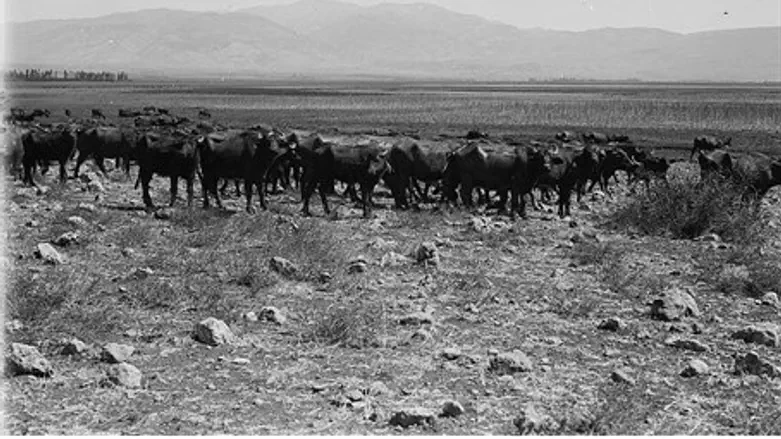
Herd of buffalo near the Hula swamps. The Golan Heights are in the background (Library of Congress, circa 1900) See also here.
Buffalo wallowing in the Hula swamps. The Naftali ridge is the background. See also here Credit: Keystone-Mast Collection, California Museum of Photography at UCR ARTSblock, University of California, Riverside)
Old maps of the Holy Land showed three bodies of water along the banks of the Jordan River -- the Dead Sea in the south, Lake Hula in the north and the Sea of Galilee in the middle.
The Hula Valley region appears in writings dating back to Josephus, but the area was not the most hospitable to human habitation. The valley is 15.5 miles long from north to south and 4-5 miles wide. One third of the valley was lake, one third was land, and one third swamps/marshes. Malaria in the region was rampant.
According to State Lands and Rural Development in Mandatory Palestine, 1920-1948 by Warwick P. N. Tyler, a concession to the Hula Valley "was granted by the Ottoman Authorities in June 1914 to two Beiruti merchants 'for the drainage and reclamation of the Hula marshes.' The concession area ...consisted of state land..."
Original caption: "Land provided to the Arabs by government, in place of area being drained. Hebrew settlement of Yesud HaMa'ala on Hula Lake" (Library of Congress, 1940)
"When the concession was granted in 1914," historian Tyler continued, "the Arab population in the Hula Valley lived in 19 villages and numbered between three and four thousand. Most belonged to the Ghawarina people -- outcasts of society, the descendants of deserters from Ibrahim Pasha's Egyptian army which had captured the region in the 1830s, escaped slaves, fugitives from the law and refugees from family feuds."
Weaving mats in a Bedouin village in the Hula Credit: Keystone-Mast Collection, California Museum of Photography at UCR ARTSblock, University of California, Riverside)
In 1882, a Jewish community, Yesud HaMa'ala, was established on the shores of the Hula Lake on land purchased in 1872 by Yaakov Chai Abu from a Bedouin tribe. Some of Yesud HaMa'ala's first settlers were members of the Sobbotnik group of converts from Russia led by the fabled Yoav Dubrovin.
Tyler wrote in a Middle East Studies article, "The Huleh [Hula] Concession and Jewish Settlement of the Huleh Valley, 1934-48, "In 1934 Jewish interests acquired the Hula concession to drain and reclaim Lake Huleh and its swamps in northern Galilee. During the previous 20 years, when the concession was in Arab hands, no significant drainage work had been undertaken. The Palestine Land Development Company agreed to pay the former concessionaires, the Salam family, £191,974 to acquire their rights."
Hula Arabs in their reed huts (The "Cigarbox" Collection)
The Arab tribe in the Hula Valley was known for their mat-weaving, pictured here. According to Tyler, they "were decimated and enfeebled by malaria and lived a wretched existence in reed houses and mud hovels."
In the 1930s, the British Mandatory government attempted to restrict Jewish land purchase "by draconian restrictions," Tyler wrote. "Any hope that a policy of [Arab] agricultural development would be implemented was dashed when Palestine was engulfed by racial strife in 1936-9."
During the 1948-1949 war and the invasion of Arab armies into the Jewish state, the Arab villagers fled.
In the 1950s, Israel undertook a national project to drain the Hula Valley to create new farmland. The damage to the region's ecological systems, however, led to a new plan to reflood part of the valley and to create wildlife preserves.




